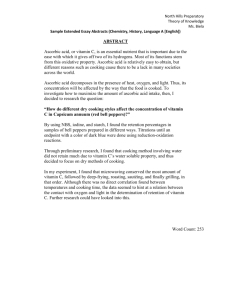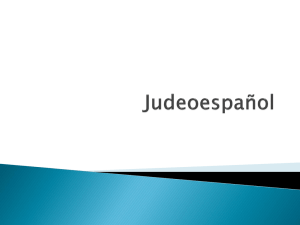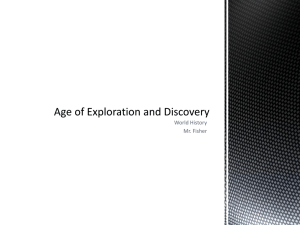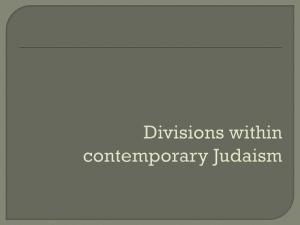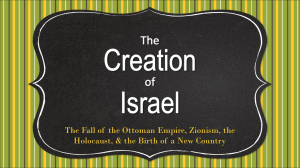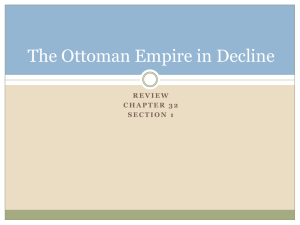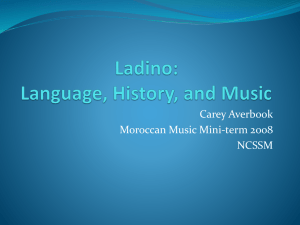Judeo-Español
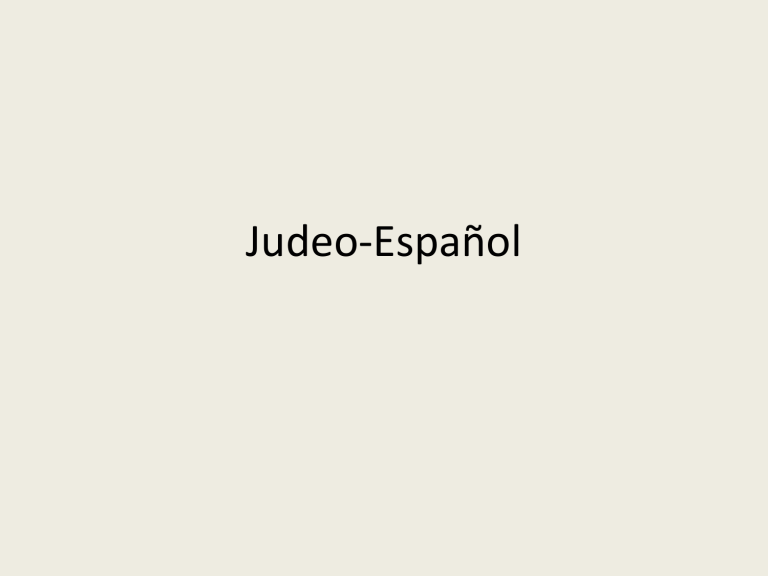
Judeo-Español
History pre-1492
• Jews played a key role in public administration.
• The helped found and influence the economy.
• Jews “opened the windows of Andalucia” (Harris).
• Prominent in certain professions: Medecine, Law, Money
Lending.
• Most learned and influential class of fifteenth century Spain.
• They served as the go-between for Christians and Muslims and so had a knowledge of Arabic which matched their knowledge of Hebrew.
• 4 th June 1391: Start of the end.
The 1492 Decree
• 31 st March 1492 – historical decree of expulsion of the Jews signed in Granada by King Ferdinand and
Queen Isabella, los reyes católicos.
• Any Jew that did not convert to Catholicism would be expelled or killed.
• Could not leave with money, gold or silver so left the country with few material belongings but with most precious possessions: their language, customs and
Spanish-Jewish heritage.
The Language of the Jews in Pre-
Expulsion Spain
• Certain differences in the language of the Christians and that of the Jews due to a religious nature.
• Jews interspersed their dialects with Hebrew words and expressions.
• Due to religious reasons, Jews were fairly isolated, lived in juderías: not exposed to as many varieties of Spanish as non-Jews were, developed a different linguistic inventory.
the need to describe technical aspects of religion (dietary laws, utensils, religious beliefs + theories) naturally lead to a
Hebrew origin. Hebrew technical vocabulary.
Post 1492
• 3 mains routes of exile: North Africa, Portugal and other European countries and Ottoman Empire
(Eastern European Empire reigning from 1299 to
1923 with Istanbul (Constantinople) as its capital).
Routes of exile
Western Europe
• A certain number of expelled Jews took refuge in Portugal but they were subjected to forced baptisms or were expelled again in 1497.
• Along with other Portuguese Jews this group went mainly to
Holland, France, England and Germany and other Western
European countries.
• 1593: first Sephardi Jews settled in Amsterdam where there was a state of bilingualism.
• Spanish was still a notable language in books and prayer.
Routes of exile
Northern Africa
• Thousands settled here especially in Northern
Morocco.
• The language they spoke developed into a mixture of Spanish and Arabic, Hakitia.
• In a large number of cases it was eventually replaced with a local form of Arabic.
Routes of exile
The Ottoman Empire
• 125,000 exiles settled in various regions, invited by the Sultan, Bayezid II, to colonise the devastated and conquered regions of the Empire and make it as commercially successful as Spain pre-1492.
• They built up small communities in which they spoke Spanish and lived autonomously.
• They enjoyed extensive freedom: had their own schools, used the language freely, emigrated abroad and maintained their use of Spanish in business and everyday life.
The Ottoman Empire Cont.
• Language was able to survive as there was no enforced national language.
• Islamic people respected Jews as a minority.
• “While the ancient Ottoman Empire existed, the use of Judeo-
Spanish was never opposed or hindered.” (Harris: 36)
• Due to its high prestige, non-Sephardic as well as non-Jews learnt Judeo-Spanish for use in business.
• Forced isolation enforced their status as foreigners – but helped maintain their language.
The Ottoman Empire Cont.
• In the 17 th century, lack of contact with the West (which was in full renaissance) and the abandonment of the Latin alphabet in favour of Hebrew characters meant that the
Judeo-Español dialect did not evolve in the same way as
Castilian.
• Influx of surrounding languages became noticeable, such as
Arabic, Hebrew, Turkish and Greek.
• Decline in the Ottoman Empire in 18 th and 19 th centuries.
Poverty and natural disasters struck the Jewish Sephardi communities.
• First half of 19 th century, Judeo-Spanish stopped being the universal language of trade.
Harris, Tracy. Death of a Language: The History
of Judeo-Spanish. Univ. of Delaware Press,
1994.
Judeo-Español Balcánico - Phonology
• Grammar and core vocab (approx 60%) are basically Castilian
• Some elements, however, closer to
Portuguese/Galician
• Retained characteristics that Castilian later lost
• Eg: aninda (still), ainda (P), aínda (G), aún (C)
• Fija (daughter), filha (P), filla (G), hija (C)
Archaic Phonological Features Retained
• Modern Spanish: v/b same bilabial phoneme
• Old Castilian and Judeo-Spanish: v is a labiodental (bivir), the distinction is made
• Modern Spanish: j pronounced [x]
• Old Castilian and Judeo-Spanish post alveolar fricatives either ‘sh’ (voiceless): baxo, or ‘zh’ (voiced): mujer
• Modern Spanish: z pronounced as ‘s’ or ‘th’ (dental – does not exist in Judeo-Spanish)
• Old Castilian and Judeo-Spanish alveolar fricatives either
ç/s (‘ts’) or z (‘dz’) - korason (coraçon, corazón), dezir
(decir)
• Conservation of initial f in some words: fumo, ferir
Some other newer phonological features
• [s] [ŝ] in the endings –ais and –eis, avlas, keres, saves.
Also in seis (ses) – as in Portug and the sk group (buskar)
• Closing of final e, o (madri, kwantu), especially in the west and northwest of the Balkan peninsular, aside from
Bucharest
• e a infront of trilled consonant (tiara), except in Romania and Serbia
• Monothongation or dipthongation ken (quien), buendad
(bondad), mostro (muestro), pueder (poder)
• rd dr (godro, vedre): the notion is intensified in forms which have maintained the rd: Verdad
• Initial n m infront of ue (muestru, muevi, muevu), mos, mozostros
Neologisms due to lexical borrowing
• Appearance of a velar consonant /x/, borrowed from Arabic, Hebrew and Balkan languages: xazinu (enfermo), malax (ángel)
• Appearance of /ŝ/ phoneme in borrowings mainly from Hebrew, ŝar (miedo), ŝava (orden)
• Z no longer only in interior of words, but may also be at start (did not occur in Old Castilian) e.g. Zaxut (food eaten at a funeral)
Other phonological phenomena
• Yeísmo, (yave) generalised with only a few exceptions in Turkey and Monastir (covers parts of Albania/Greece/Macedonia)
• Disappearance of ñ ni (aniu, punio) in Ruse
(Bulgaria) and Bucharest (Romania)
• Multiple trill /ŕ/ simple trill /r/ in Bucharest
(ariba, barer, tiera)
Judeo-Español Balcánico -
Morphology
Pronouns
• Usted and ustedes do not exist
• Instead ‘vos’ is used for formal singular and
‘vosotros’ for formal plural
• Tú is maintained for second person, informal singular
• ‘os’ does not exist in Judeo-Español. ‘vos’ is used instead
Verb Conjugations
• Present
• very similar to modern Castilian
• E.g. Regular –ar verb avlar (hablar):
Yo avlo
Tu avlas
El/eya avla
Mosotros avlamos
Vozotros avl ásh - habláis
Eyos/eyas avlan
–er and –ir verbs
• Similarly, only the you plural ending is different to the endings of modern Castilian
• E.g. komer
Yo komo
Tu komes
El, eya kome
Mosotros komemos
Vozotros kom ésh - coméis
Eyos, eyas komen
Preterite
• E.g. Regular –ar verb Avlar
Avl í – é (í is used at the end)
Avl ates - aste
Avló
Avl i mos - amos
Avl atesh - asteis
Avlaron
Regular –er verb e.g. komer
• Komí
• Kom ites - iste
• Kom y ó - ió
• Komimos
• Kom itesh - isteis
• Kom y eron – ieron
Imperfect
• Ending –iƀa (iva) is used where modern Castilian uses ía
• E.g. kiriƀa – quería, riyiƀa - reía
General Points
• First person present endings –oy e.g. estoy, soy, voy,
Judeo-Spanish use –o instead. E.g. estó, so, vo
• In general the plural endings for judeo-Spanish words are –im for masculine plurals and –ot for feminine plurals.
• These endings mainly appear in words of Hebrew origin. E.g. batlanim –ociosos, beemot (bema) – bestia.
• -im is also sometimes used to make plurals of words of Spanish origin. E.g. ladronim, ermanim, retonim.
Continued
• They are also used for words of Turkish origin.
E.g. seraphim – usureros, kasapim – carniceros
• Due to influence from Balkan languages, the subjunctive is used where, for certain expressions, modern Castilian would use the imperfect
• E.g. kali se la deše – tiene que dejarla (in
Bitola and Skopje – Macedonia)
Judeo-Español de Marruecos-
Phonology
• Prothesis of –a
• Addition of letter at the beginning of the word
• E.g. arrobar, adormir, aprestar.
• Common feature of all types of Spanish
• Aphaeresis
• Loss of sound at the beginning of a word
• E.g. šuar – ajuar, parece – aparece
Changeability in the unstressed vowel
• E.g. dizzilde – decidle, pidiste, asperando, sospiro
• These can be found in a complete dictionary of Moroccan Judeo-Spanish, where parecer, dicer, pider, asperar, o sospirar can be found
• This changeability can affect the conjugation, where it wouldn’t be rare to hear mole – muele.
Paragoge
• Addition of the old –e to Moroccan Judeo-
Spanish words, not just after an –r, but in other cases. E.g. gavilane, lumbrale, pesare, veluntade (- voluntad).
• In Morocco, this is used in Hebrew words
(cahale – comunidad), or Arabic words (ašuare
– ajuar). It is thought that this added –e at the end of the words is unnecessary.
Castilian Archaisms
• Sibilant Consonants
• This is conserved from old Castilian
• Distinction between unvoiced S and voiced Z
(although the S is pre-dorsal).
• “The most maintained and archaic element, and the most characteristic of the dialect.”
• Vitality is unquestioned.
Difference between š and ž (j)
• Pre-palatal voiced and unvoiced fricatives respectively
• Castilian words (cobijar – covižar), but also from Arabic (šorreados – arrastrados)
• It is possible that in this case, the maintenance of this sound is helped by the same sound in
Arabic, which already appears to be the case for the modern Castilian jota (gente).
Difference between Ѳ and the Z
• Voiced and unvoiced alveolar affricatives
• Most vulnerable distinction between letters, especially since Andalucian Z – unvoiced postdental fricative.
Yeísmo
• Disappearance of the ‘y’
• When in contact with í (portío, Castía, ahí)
• Well known phenomenon in all Spanish languages, but in terms of Judeo-Spanish, this comes from the second half of the 17 th century.
Lengthening of Consonants
• Used in Moroccan Judeo-Spanish, influenced by
Arabic
• E.g. s - SS (dos-sientos), d-dd (meatad del corazón)
• Adding of 2 different consonants together
• E.g. r+l = l-l (contal-la)
• L+r = rr
• N+l = l-l (el la – en la)
• N+m = mm (emmano)
Initial -F
• Occurs in many words, e.g. fadar, folgar, filos, faldiquera
• Due to the geographical origin of the
Sephardic people in Morocco.
Loss of final –s, -n and -r
• Like in Andaluz, leads to vocal opening, although not always.
• Also as in Andaluz, there is often loss of the final –n (chapí, cordobá)
• Loss of final –r (azumbé – azumbar).
Judeo-Español de Marruecos – Morphology
• Archaisms retained: Naide (Nadie), Mosotros, Mos,
Muestros
Verbal perculiarities:
• -er verbs -ir (eg vister for vestir, suber for subir) – ir verbs unchanged (vivir, depedir)
• Preterite: sení (cené), encontrí (encontré), vide (ví)
• -ad, -id lose the ‘d’ (dejá, vení), but also levantai
(levantad), daime (dadme) – similar to leonese
• -d + -l ld (dezilde)
• -imus -emos (venemos) y –tis: retained old form – des (quieríades, besedéisme – me beseís)
LANGUAGE DEATH
What is “language death?”
• Fishman 1964: “language shift” versus
“language maintenance.”
• Fasold 1984: “the members of a community, when the shift has taken place, have collectively chosen a new language where an old one used to be used.”
• Desire for social mobility or a better standard of living.
How does a language die?
• minority or ethnic languages of a lower prestige and spoken by only a small part of the community’s population.
• Unstable bilingualism.
• Fasold: “a substantial proportion of the individuals in a society seldom completely give up the use of one language and substitute another one within their lifetime. In the typical case, one generation is bilingual, but only passes on one of the two languages to the next.”
• First generation: fluent in original language.
• Second generation: Bilingual (in both original and replacing language)
• Third generation: fluent in replacing language.
The situation of Judeo-Spanish today…
• United States, Israel and turkey
• 1966: 360,000 speakers
• 1979: 160,000 speakers
• Today: 60,000 speakers
• Only 42% of the children of those who can speak
Judeo-Spanish have a passive knowledge of the language.
• 100% of the grandchildren cannot speak it at all.
Lack of institutional or community support
...
• THE ETHNIC MOTHER TONGUE PRESS AND
PUBLICATIONS
• ETHNIC LANGUAGE BROADCASTING ON BOTH
RADIO AND TELEVISION
• NON-ENGLISH ETHNIC MOTHER TONGUE
SCHOOLS
• LOCAL RELIGIOUS UNITS UTILIZING
LANGUAGE S OTHER THAN ENGLISH
How did the process of the death of Judeo-
Spanish begin?
1.NATIONALISM IN THE BALKANS:
• Closing of Jewish schools
• Obligatory military service
• Introduction of “Turkish Unity”
• 2. LOSS OF PRESTIGE:
• New international trade agreements
• 3.ASSIMILATION IN THE OTTOMAN EMPIRE
• 4. AMERICANIZATION & ISRAELIZATION
• 5. FRENCH INFLUENCE – THE ALLIANCE ISRAELITE
UNIVERSELLE SCHOOLS IN THE LEVANT
• 6. OTHER FOREIGN INFLUENCES: A POLYGLOT MIXTURE
• 7. ABSORPTION BY OTHER ROMANCE LANGUAGES
• 8. HEBREW IS REINFORCED AS THE LANGUAGE OF
RELIGION AND WAS REVIVED AS THE NATIONAL
LANGUAGE OF ISRAEL.
• 9. NO SEPHARDIC SCHOOLS TO PROMOTE RELIGION OR
SEPHARDIC CULTURE
• 10. NO LANGUAGE ACADEMY OR CENTRAL
ORGANIZATION TO ESTABLISH LINGUISTIC NORMS
• 11. LIMITED EDUCATION IN THE MOTHER TONGUE –
ILLITERACY IN JUDEO-SPANISH
• 12. USE OF THE HEBREW ALPHABET INSTEAD OF
THE LATIN ALPHABET
• 13. COMPLETE BREAK OF RELATIONS WITH SPAIN
• 14. NO PRESTIGIOUS JUDEO – SPANISH
LITERATURE
• 15. CONTACT WITH ASHKENAZIM –
ASHKENIZATION
• 16. INTERMARRIAGE (Sephardic Jews with
Ashkenazi)
• 17.DISPERSAL OF SEPHARDIC NEIGHBOURHOODS
• 18. NO POWERFUL MOVEMENTS TO CHAMPION
THE CAUSE OF THE JUDEO – SPANISH LAMGUAGE
OR ITS PRESERVATION EVEN ON THE PART OF THE
SEPHARDIM THEMSELVES
• 19. NO EFFECTIVE CENTRAL UNITING SEPHARDIC
ORGANIZATIONS
• 20. NO “OLD COUNTRY” OR HOMELAND – NO
NEWLY ARRIVING IMMIGRANTS
• 21. REDUCTION OF THE SEPHARDI POPULATION
• 22. REDUCTION OF LANGUAGE DOMAINS OR
USES
Is a Judeo-Spanish Revival possible?
• No monolingual speakers or young Judeo-
Spanish speakers
• Critical stage in its history
• Fishman: “threatened languages whose intergenerational continuity is proceeding negatively, with fewer and fewer users, are often beyond the help of efforts to reverse language shift.”
Conclusion…
• Denison (1977): “the direct cause of ‘language death’ is seen to be social and psychological: parents cease transmitting the language in question to their offspring.”
• Edwards (1985): “Languages themselves obviously obey no organic imperatives, but their speakers do. Languages do not live or die at all…Yet they clearly do have an ‘allotted life’ which is granted, not by the laws of nature, but by human society and culture. The fortunes of language are bound up with those of its users, and if languages decline or ‘die’ it is simply because the circumstances of their speakers have altered. The most common scenario here is that involving language contact and conflict: one language supplants another.”
